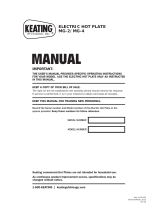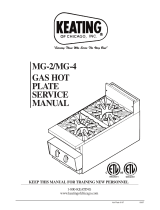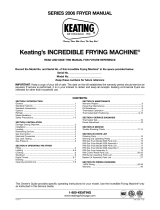Page is loading ...

1-800-KEATING
www.keatingofchicago.com
Users Manual
ELECTRIC HOT PLATE
MG-2/MG-4
READ AND SAVE THIS MANUAL FOR FUTURE REFERENCE.
Keep this manual for training new personnel.
SECTION I: INTRODUCTION
GENERAL INFORMATION . . . . . . . . . . . . . . . . . . . . . . . . . . . . . . . . .1
RATINGS . . . . . . . . . . . . . . . . . . . . . . . . . . . . . . . . . . . . . . . . . . . . . . . .1
OPTIONS . . . . . . . . . . . . . . . . . . . . . . . . . . . . . . . . . . . . . . . . . . . . . . . .1
STANDARD FEATURES . . . . . . . . . . . . . . . . . . . . . . . . . . . . . . . . . . . .1
MODEL VARIATIONS . . . . . . . . . . . . . . . . . . . . . . . . . . . . . . . . . . . . . .1
SAFETY PRECAUTIONS . . . . . . . . . . . . . . . . . . . . . . . . . . . . . . . . . . .1
SECTION II: INSTALLATION
DAMAGE DURING SHIPMENT . . . . . . . . . . . . . . . . . . . . . . . . . . . . .2
INSTALLATION . . . . . . . . . . . . . . . . . . . . . . . . . . . . . . . . . . . . . . . . . . . .2
POSITIONING . . . . . . . . . . . . . . . . . . . . . . . . . . . . . . . . . . . . . . . . . . . .2
RESTRAINING DEVICES . . . . . . . . . . . . . . . . . . . . . . . . . . . . . . . . . .2
ELECTRICAL CONNECTION . . . . . . . . . . . . . . . . . . . . . . . . . . . . . . .2
SECTION III: OPERATING
LIGHTING . . . . . . . . . . . . . . . . . . . . . . . . . . . . . . . . . . . . . . . . . . . . . . .2
SHUTDOWN . . . . . . . . . . . . . . . . . . . . . . . . . . . . . . . . . . . . . . . . . . . . .3
CLEANING . . . . . . . . . . . . . . . . . . . . . . . . . . . . . . . . . . . . . . . . . . . . . . .3
SECTION IV: MAINTENANCE
WARRANTY REPAIRS . . . . . . . . . . . . . . . . . . . . . . . . . . . . . . . . . . . . .3
PREVENTIVE MAINTENANCE . . . . . . . . . . . . . . . . . . . . . . . . . . . . . .3
SECTION V: ORDERING PARTS
ORDERING PARTS . . . . . . . . . . . . . . . . . . . . . . . . . . . . . . . . . . . . . . .3
WARNING AND OPERATING PLATES . . . . . . . . . . . . . . . . . . . . . . .3
HOT PLATE PARTS LIST . . . . . . . . . . . . . . . . . . . . . . . . . . . . . . . . . . .4
HOT PLATE ASSEMBLY . . . . . . . . . . . . . . . . . . . . . . . . . . . . . . . . . . .4
SECTION VI: WIRING DIAGRAMS
HOT PLATE WIRING AND LADDER DIAGRAMS . . . . . . . . . . .5-11
WARRANTY . . . . . . . . . . . . . . . . . . . . . . . . . . . . . . . . . . . . . . . . . . . .12
CONTENTS:
IMPORTANT:
Keep a copy of your bill of sale. The date on the bill establishes the warranty period should
service be required. If service is performed, it is in your interest to obtain and keep all receipts. Keating
commercial hot plates are not intended for household use.
The Owner’s Guide provides specific operating instructions for your model. Use the Electric Hot Plate
only as instructed in this Owner’s Guide.
electricHotPlate
05/11
part# 037430
RECORD THE MODEL AND SERIAL
NUMBERS OF THIS ELECTRIC HOT PLATE
IN THE SPACES PROVIDED.
SERIAL NO. ______________________________
MODEL NO. _____________________________
KEEP THESE NUMBERS FOR FUTURE REFERENCE.
*AS CONTINUOUS PRODUCT IMPROVEMENT OCCURS, SPECIFICATIONS MAY BE CHANGED WITHOUT NOTICE.

POST THIS LABEL IN A
PROMINENT LOCATION ON
YOUR UNIT.
i
THIS EQUIPMENT MUST BE SECURELY ATTACHED TO A RIGID
STRUCTURE BEFORE OPERATION.
INSTALLER:
DO NOT CONNECT ELECTRICITY TO THIS UNIT BEFORE IT IS
SECURED TO PREVENT TIPPING.
IMPROPER INSTALLATION, ADJUSTMENT,
ALTERATION, SERVICE OR MAINTENANCE CAN
CAUSE PROPERTY DAMAGE, INJURY OR DEATH.
READ THE INSTALLATION, OPERATING AND
MAINTENANCE INSTRUCTIONS THOROUGHLY
BEFORE INSTALLING OR SERVICING THIS
EQUIPMENT.
WARNING
Improper installation
can cause damage,
injury or death.
ShockBurnsGas

I INTRODUCTION
GENERAL
Keating MG-2 and MG-4 Hot Plates are designed to
give maximum production efficiency; delivering high
quality food products. The following design features are
incorporated in all Keating Hot Plates.
STANDARD FEATURES
Highly polished stainless steel front
Infinite controls
12" working height
Heating elements with pans
Easy access for servicing
100% factory testing
OPTIONS
24" or 30" depth
MODEL VARIATIONS
MG-2 Model: The MG-2 model has two elements
MG-4 Model: The MG-4 model has four elements
SAFETY PRECAUTIONS
WARNING
THIS SYMBOL WARNS YOU THAT SERIOUS BURNS
OR OTHER INJURIES MAY RESULT IF SAFETY
INSTRUCTIONS ARE NOT FOLLOWED.
This service manual should be retained in a safe
place for future reference.
The installation of your new hot plate must conform
to local codes or in the absence of local codes, with the
current National Electrical Code ANSI/NFPA 70 or
Canadian Electrical Code CAN 22.2 as applicable.
Your ventilation hood, when installed, must conform
to the current ANSI/NFPA 96 standard.
No frame or restriction shall be constructed around
the hot plate that will restrict air movement or prevent
proper ventilation.
Suitable for installation on combustible surfaces.
You must maintain this appliance free and clear from
combustibles.
You must maintain the following minimum clearances
from combustible and noncombustible construction:
Clearances:
Combustible Noncombustible
Construction
Construction
Back 6" 0"
Right Side 6" 0"
Left Side 6" 0"
You must install this appliance at least 16" away from
any open flame.
Adequate clearance for servicing and proper
operation must be maintained. Your hot plate is
designed to be serviced from the front.
Keating commercial hot plates are not intended for
other than household use. Installation in household
voids warranty.
ALWAYS instruct new employees on proper hot plate
operation.
A hot plate should be operated ONLY by properly
trained personnel.
ALWAYS turn hot plate off each night.
ALWAYS disconnect electrical supply before
servicing.
NEVER leave a hot plate unattended during
operation.
NEVER introduce objects into hot plate, while
operational, which are not designed or made for
cooking.
THIS HOT PLATE MAY NOT BE ALTERED,
MODIFIED OR CHANGED IN ANY WAY.
Safe operation of this equipment is
possible only when the operating
instructions and the safety precautions
are read completely and the instructions
contained therein are strictly observed.
Before operating this equipment, ask for
a practical demonstration.
Periodically inspect cable and plug, if
provided, before using machine.
Servicing should be performed by
qualified and licensed service
companies.
II INSTALLATION
This hot plate MUST be installed, inspected, and
serviced by qualified and/or certified and/or licensed
service personnel – you may void your Keating warranty
if installation is not completed per current local, national
and Keating specifications. Contact your dealer for
assistance.
1
CAUTION
Read all operating and
safety instructions
before using equipment.
WARNING
Plug into a
properly grounded
three-prong receptacle.

2
DAMAGE DURING SHIPMENT
The hot plate has been assembled, tested and
inspected at the factory. Upon arrival, the complete hot
plate should be checked for any damage that may have
occurred during shipment.
The carrier is responsible for all damage in transit
whether visible or concealed. Do not pay for the freight
bill until the hot plate has been thoroughly checked for
damage. If concealed damage is found later, contact the
carrier immediately to file a claim.
What to do if equipment arrives damaged:
VISIBLE LOSS OR DAMAGE – Be certain to note this
on the freight or express receipt and have it signed by
the delivery person.
FILE CLAIM FOR DAMAGES IMMEDIATELY –
Regardless of extent of damage.
CONCEALED LOSS OR DAMAGE – If damage is
noticed when equipment is unpacked, notify the freight
company immediately, and file a “concealed damage
claim”. This MUST be done immediately. Be sure to
retain the shipping container for inspection.
Keating does not assume responsibility for Loss OR
Damage incurred in transit.
INSTALLATION
Installation must conform with local codes or, in
absence of local codes, with the current National
Electrical Code ANSI/NFPA 70 or Canadian Electrical
Code CAN22.2 as applicable.
POSITIONING
The hot plate must be placed under an exhaust hood
with a fire retardant system. Your ventilation hood, when
installed, must conform to the current ANSI/NFPA 96
standard. ALL connections and placement must comply
with local and national codes. It is the responsibility of
the owner and local installer to comply with these
regulations when installing the hot plate.
NOTE: NOT FOR OUTDOOR INSTALLATION
RESTRAINING DEVICES
Hot plates must be restrained to
prevent tipping when installed in
order to avoid splashing, spilling, etc.
of hot liquid. The restraining method
may be a manner of installation or by
separate means. Adequate means
must also be provided to limit the
movement of the appliance.
IF DISCONNECTION OF THE RESTRAINT IS
NECESSARY, IT MUST BE RECONNECTED WHEN
THE HOT PLATE IS RETURNED TO ITS ORIGINALLY
INSTALLED POSITION.
ELECTRICAL CONNECTION
The Keating Electric Hot Plate is equipped with a three
wire terminal block for customer connections. Compare
the hot plate terminal connections to the appropriate
wiring diagram for the hot plate (see pages 5-11 Wiring
Diagram) to see if the hot plate is connected three
phase or single phase. All wires, cords, plugs,
receptacles and circuit breakers must be sized
adequately for the full load rating of the griddle as
specified by local codes or, in the absence of local
codes, by the current National Electrical Code
ANSI/NFPA 70 or the Canadian Electrical Code CAN
22.2 as applicable.
The Electric Hot Plate is also equipped with a grounding
lug next to the terminal block. For proper grounding
procedures, see local codes or, in the absence of local
codes, the current National Electrical Code ANSI/NFPA
70 or the Canadian Electrical Code CAN 22.2 as
applicable.
NOTE: The connections to the hot plate can be
changed in the field from three phase to single phase or
from single phase to three phase. This can be done by
simply changing the wiring at the terminal block. To
change the connections for your hot plate, see the
wiring diagram for your griddle on pages 5-11.
NOTE: For hot plates rated at 208-240 volts, the
amperage ratings marked on the nameplates of the
griddles are listed at 240 volts as required by UL.
NOTE: A hole has been punched in the rear of the hot
plate cabinet for a cord or conduit exit. If a cord is used,
the National Electrical Code, UL standards and most
local codes require a bushing or strain relief (not
provided by Keating) to protect the cord.
III OPERATING
LIGHTING
Keating hot plates are designed to provide maximum
efficiency and deliver high quality food products. Follow
lighting procedure below.
WARNING
OPERATION OF THIS HOT PLATE SHOULD BE
LIMITED TO PERSONNEL WHO HAVE BEEN
THOROUGHLY TRAINED IN OPERATING
WARNING
Do not stand, sit or
lean on equipment.

PROCEDURES.
1. Push in the red knob and rotate it fully
counterclockwise to the desired setting.
NOTE: The left knob operates the back burner and the
right knob operates the front burner.
SHUTDOWN
1. Rotate the red knob fully clockwise for each burner.
CLEANING
When cleaning your hot plate, use Keating Klenzer, the
finest dry stainless steel polish available, to restore your
hot plate’s exterior to it original luster.
CAUTION: Disconnect the electrical power source
before doing any cleaning.
IV MAINTENANCE
WARRANTY REPAIRS
Keating’s warranty begins with the date of installation. In
the event that your hot plate, under warranty, needs
repairs other than routine maintenance or cleaning, you
are requested to contact Keating of Chicago (at 1-800-
KEATING) before calling a local service company.
PREVENTIVE MAINTENANCE
Preventive maintenance should be done in daily,
weekly, and monthly intervals as necessary. Following
preventive maintenance procedures will help keep your
hot plate working efficiently. Proper care and servicing
will lead to years of quality performance.
V PARTS LISTS
ORDERING PARTS
Parts may be ordered by part number by calling Keating
at 1-800-KEATING or your service company. You may
also order on-line at Keating’s part store,
www.keatingofchicago.com
Refer to the Keating Hot Plate Limited Warranty for
complete service and ordering information.
The model/serial plate is located on the front of the
control panel. The serial and model numbers are
necessary when ordering.
WARNING AND OPERATING
PLATES
All warning and operating plates on the Keating Hot
Plate should be in a place at all times. If plates are
damaged or lost, replace them immediately.
3
PREVENTIVE MAINTENANCE CHART
TIME FRAME OPERATOR/OWNER SECTION
At Least Daily* • Check controls
• Drain and clean drip
pan
III
III
At Least
Weekly
• Clean hot plate III

4
MG-2 MODEL MG-4 MODEL
ELECTRIC PLATE PARTS LIST
PART
ITEM DESCRIPTION MG-2 MG-4 NUMBER
1 ELEMENT 240V 2600W WITH PAN 2 4 037586
2 ELEMENT PAN ONLY 2 4 037378
2 ELEMENT RING ONLY 2 4 039233
3 INFINITE CONTROL 2 4 011614
4 INFINITE CONTROL KNOB ONLY 2 4 037587
5 INDICATING LIGHT, AMBER, 240V 2 4 050255
6 TERMINAL BLOCK (NOT SHOWN) ------
208- 240 VOLT UNITS 1 2 034381
FOR 480 VOLT UNITS 4 026241
7 CONTACTORS (NOT SHOWN) 2 4 011184
8 RESISTORS (NOT SHOWN) 4 8 037308
9 TRANSFORMERS (NOT SHOWN) ------
240/480V PRIMARY 120/240 SECONDARY 1 1 059433
440-220V PRIMARY 220-110V SECONDARY 1 2 059603
1
2
3
4
5
1
2
3
4
5

5
VI WIRING DIAGRAMS
MG-2 208- 240 VOLT SINGLE PHASE

6
MG-2 208- 240 VOLT 3 PHASE

7
MG-2 480 VOLT SINGLE PHASE WITH
RESISTORS FOR 240V HEATING ELEMENTS

8
MG-2 480 VOLT 3 PHASE WITHOUT RESISTORS
FOR 240V HEATING ELEMENTS

9
MG-4 208- 240 VOLT SINGLE PHASE

10
MG-4 208- 240 VOLT 3 PHASE

11
MG-4 480 VOLT 3 PHASE WITHOUT RESISTORS
FOR 240V HEATING ELEMENTS


SERVICE INFORMATION
If you have a service related question call 1-800-KEATING.
Please state the nature of the call; it will ensure speaking with the appropriate person.
Have your serial and model number available when ordering parts.
KEATING OF CHICAGO, INC.
8901 W. 50th Street, McCook, Illinois 60525-6001
Phone: (708) 246-3000 FAX: (708) 246-3100
Toll Free 1-800-KEATING (In U.S. and Canada)
www.keatingofchicago.com
*As continuous product improvement occurs, specifications may be changed without notice.
KEATING LIMITED WARRANTY CARD
PLEASE COMPLETE AND MAIL AT ONCE–WARRANTY IS NOT IN EFFECT UNTIL CARD IS RETURNED.
WARRANTY CARD IS ALSO AVAILABLE TO COMPLETE ON LINE AT YOUR CONVENIENCE.
COMPANY: ________________________________________________________________________________________________
ADDRESS: ________________________________________________________________________________________________
CITY: ____________________________________________________________ STATE: ____________ ZIP: ________________
DEALER: __________________________________________________________________________________________________
DATE OF PURCHASE: ______________________________________________ INVOICE NUMBER: ______________________
SERIAL NUMBER:
__________________________ FRYER FILTER SYSTEM GRIDDLE
REMARKS:
________________________________ TOP-SIDE COOKER HOT PLATE PASTA PLUS
I HAVE READ THE INSTALLATION AND OPERATION INSTRUCTIONS.
SIGNED: ________________________________________________________________ DATE:
________________________
Serving Those Who Serve The Very Best
/







